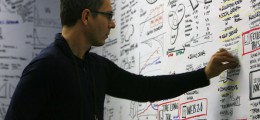 In 2009, Charles Jacobs published a book entitled Management Rewired: Why Feedback Doesn’t Work and Other Surprising Lessons from the Latest Brain Science. In it, he discusses the power of mental paradigms and what leaders must do to change behavior. According to Jacobs research, we interpret the world and structure our behavior according to a narrative of our own creation. A story we repeatedly play in our heads which helps us define, analyze and categorize all we see and experience. More importantly, it is a story with an implicit set of rules that define the way we believe the world works and dictates how we behave in response to it.
In 2009, Charles Jacobs published a book entitled Management Rewired: Why Feedback Doesn’t Work and Other Surprising Lessons from the Latest Brain Science. In it, he discusses the power of mental paradigms and what leaders must do to change behavior. According to Jacobs research, we interpret the world and structure our behavior according to a narrative of our own creation. A story we repeatedly play in our heads which helps us define, analyze and categorize all we see and experience. More importantly, it is a story with an implicit set of rules that define the way we believe the world works and dictates how we behave in response to it.
Because this story defines our mental paradigm, is self-reinforcing and drives our daily behavior, the only way to change behavior is to invalidate the current paradigm and replace it with a “new storyline.” To do this, we must create cognitive dissonance and demonstrate that the rules that govern the current worldview no longer apply. We need to shock the system and interject something new…something unexpected. By introducing information that runs counter to what is expected, the right hemisphere of the brain fires up, takes a step back and reflects. Since the right hemisphere is responsible for reflective consciousness, processing “big picture concepts” and creative expression, we need to have it engaged for people to drive daily innovation.
So how do we do this? Since the brain is programed to reinforce the status quo, how do we introduce new information in a way that stops the brain in its tracks? Visual management.
When done right, a simple visual (coupled with clear expectations) provides the brain with new information about the status of a process and presence of an abnormality. Team members are quickly able to see whether the process is performing as expected or a problem has occurred. Whereas without the visual, the story told may have reinforced a worldview that everything was “ok,” the presence of the visual forces the brain to take a step back, reflect, and reconcile its current paradigm with the new information.
So when driving continuous improvement, never underestimate the power of simple meaningful visuals. Our brains are programmed to see, analyze and interpret information based on a self-reinforcing story playing in our head. We construct our own view of the world and the only way to change our thinking (and thus our behavior) is to be presented with new information in a way that can’t be ignored. Often the simple act of creating “a spot of red in a sea of green” can be the catalyst for significant behavioral change.




Leave a Reply